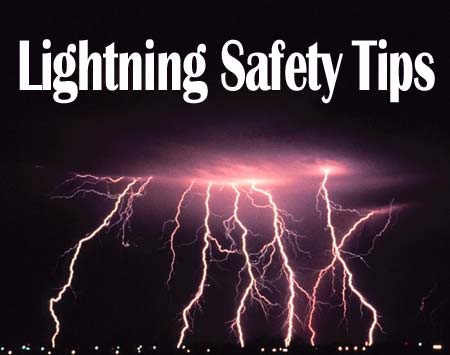Stay Safe: Crucial Tips for Lightning Awareness
Protect yourself during storms with these lightning safety tips. Seek shelter indoors, avoid open areas, and stay away from water. Unplug electronic devices and wait 30 minutes after the last rumble before resuming activities. Prioritize safety to mitigate the risks associated with lightning strikes.
Seek Shelter Indoors:
When you hear thunder or see lightning, seek shelter immediately. Move indoors to a sturdy building or a hard-topped vehicle to stay safe from lightning strikes.
- Seek shelter indoors immediately.
- Stay in a sturdy building or a hard-topped vehicle.
- Avoid open areas, tall trees, and bodies of water.
Avoid Electrical Appliances:
Refrain from using electrical appliances and avoid plumbing fixtures during a lightning storm. Lightning can follow conductive materials, posing a risk of electric shock.
- Avoid using electrical appliances during a storm.
- Refrain from using plumbing fixtures to reduce the risk of electric shock.
- Unplug electronic devices to prevent damage from electrical surges.
Stay Away from Windows:
Stay away from windows during a lightning storm to minimize the risk of injury from shattered glass in case of a lightning strike nearby.
- Stay away from windows during a lightning storm.
- Avoid using corded phones and electrical equipment.
- Close curtains or blinds to prevent shattered glass.
Wait for the All-Clear:
Wait at least 30 minutes after the last clap of thunder before resuming outdoor activities. Lightning can still pose a threat even after the rain has stopped.
- Wait at least 30 minutes after the last clap of thunder before resuming activities.
- Stay informed about weather conditions through a reliable source.
- Monitor the sky for any signs of ongoing lightning activity.
Have a Lightning Safety Plan:
Develop and communicate a lightning safety plan for outdoor activities. Designate safe shelters and establish protocols for lightning alerts.
- Develop a lightning safety plan for outdoor activities.
- Designate safe shelters in advance.
- Establish protocols for receiving and responding to lightning alerts.
Stay Informed:
Stay informed about weather forecasts and lightning activity in your area. Use weather apps or a NOAA Weather Radio for real-time updates.
- Stay informed about weather forecasts and lightning activity.
- Use weather apps or a NOAA Weather Radio for real-time updates.
- Be aware of the weather conditions before planning outdoor activities.
Avoid Water Activities:
Avoid swimming, boating, or participating in water activities during a lightning storm. Bodies of water are conductive, increasing the risk of lightning strikes.
- Avoid swimming, boating, or water activities during a lightning storm.
- Seek shelter in a sturdy building or vehicle if you are on the water.
- Wait for the storm to pass before resuming water-related activities.
Use the 30-30 Rule:
If the time between seeing lightning and hearing thunder is 30 seconds or less, seek shelter immediately. Wait at least 30 minutes after the last clap of thunder before leaving your safe location.
- Use the 30-30 rule: if the time between seeing lightning and hearing thunder is 30 seconds or less, seek shelter.
- Wait at least 30 minutes after the last clap of thunder before leaving your safe location.
- Be vigilant and follow the rule to minimize the risk of lightning-related injuries.
lightning safety tips indoors and outdoors
Lightning Safety Tips for outdoor
The best resistance is to avoid lightning. Here we are advising you some outdoor safety tips that can help you to avoid being sock:
Do the following things
- Be careful
Check out the weather prediction before participating in outdoor activities. If the forecast says about thunderstorms, rearrange your trip or movement, or make sure sufficient safe shelter is willingly obtainable. Try to go inside the room as soon as possible.
Don’t do the following things
- Stay in open vehicles, structures, and spaces
At the time of a thunderstorm, try to avoid open vehicles such as motorcycles. Make sure to avoid open spaces. - Stay near tall structures
Never lay down on concrete floor during a thunderstorm. Also, avoid propensity on concrete walls. Lightning can go through any metal things or bars in concrete walls or to the floor.
Lightning safety tips for indoor
Even although your sweet home is one of a safe place during a lightning, you may still at risk. Near about one-third of lightning hit damage occur indoors. Here we are advising some tips to keep safe and reduce your risk of being struck by lightning while you are indoors.
- Always avoid water
Do not take bathe, shower, wash dishes, or have any other contact with water during a thunderstorm because lightning can go through also the building’s plumbing. - Try to avoid electronic devices
Do not use your laptops, desktops, gaming systems, washers, dryers, oven, or anything connected to an electrical pipe. Lightning can go through electrical systems, broadcasting and television function systems, and any metal wires or any other things made by metal in concrete walls or flooring. Prepare homes with whole-house pour protectors to protect domestic devices.
[bws_related_posts]








